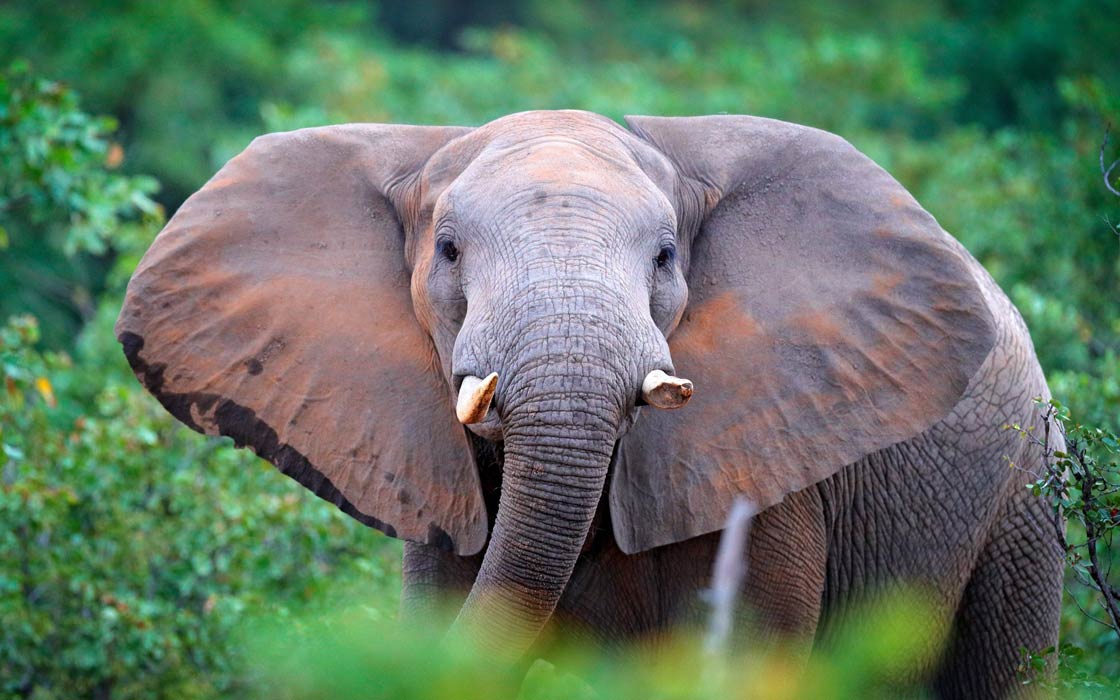African forest elephant (Loxodonta cyclotis)
The African forest elephant (Loxodonta cyclotis) is a species of the African elephant that is native to the dense rainforests of Central and West Africa. These elephants are smaller in size compared to their savannah-dwelling counterparts and have a number of adaptations that enable them to thrive in their forest habitat.
One of the most notable differences between forest and savannah elephants is their size and shape. African forest elephants are smaller, with a shoulder height of around 2.4–3.0 m (7 ft 10 in – 9 ft 10 in) and a weight of around 2,000 to 4,000 kg (4,400 – 8,800 lb). They also have a more slender build, with longer legs and smaller ears. This is an adaptation to their forest habitat, where they need to navigate through dense vegetation and navigate narrow paths.
Another adaptation of African forest elephants is their diet. They feed on a variety of plants, including fruits, leaves, and bark, as well as some mineral-rich soils. They are also known to consume certain species of woody plants, which is unusual among elephants.
African forest elephants also have a number of physical characteristics that help them to survive in the forest. For example, their trunks are more flexible than those of savannah elephants, which allows them to grasp small branches and fruits more easily. They also have long, curved tusks that are used for foraging and defense.

These elephants have also a different social structure than the savannah elephants. Forest elephants live in small family groups, typically consisting of a single adult female and her offspring, whereas savannah elephants form larger herds led by a dominant male. African forest elephants have a matriarchal society and live in tight-knit family groups that are led by an older female.
Despite their smaller size, African forest elephants are still powerful animals. They are capable of breaking down trees and clearing large areas of vegetation, which can have a major impact on their forest habitat. They also play an important role in seed dispersal, helping to maintain the biodiversity of the forest ecosystem.
Unfortunately, African forest elephants are facing a number of threats to their survival. They are often hunted for their tusks, which are highly valued for their ivory. Habitat loss due to human activities also continues to threaten their survival. As a result, African forest elephants are considered to be endangered and are listed on the IUCN Red List of Threatened Species.

Taxonomy and Phylogeny
The African forest elephant (Loxodonta cyclotis) is a subspecies of the African elephant, which is scientifically classified in the family Elephantidae, order Proboscidea, and class Mammalia. The African forest elephant’s closest relative is the African savannah elephant (Loxodonta africana), with which it shares the genus Loxodonta.
Phylogenetically, elephants are the most recent surviving clade of the order Proboscidea, which also includes extinct groups such as mammoths and mastodons. The African forest elephant and the African savannah elephant diverged from a common ancestor around 2-7 million years ago, with the forest elephant evolving to adapt to the dense rainforest habitat.
Recent genetic studies have shown that the African forest elephant is a distinct and separate subspecies from the African savannah elephant, and not just a small variant of the bush elephant as previously thought. The African Forest elephant is considered a distinct species by some scientists, which is the Loxodonta cyclotis.
The African forest elephant’s classification and phylogeny reflect its unique adaptations and evolutionary history as a subspecies of the African elephant, which has adapted to live in the dense rainforests of Central and West Africa.
Classification
- Kingdom: Animalia
- Phylum: Chordata
- Class: Mammalia
- Order: Proboscidea
- Family: Elephantidae
- Genus: Loxodonta
- Species: Loxodonta cyclotis
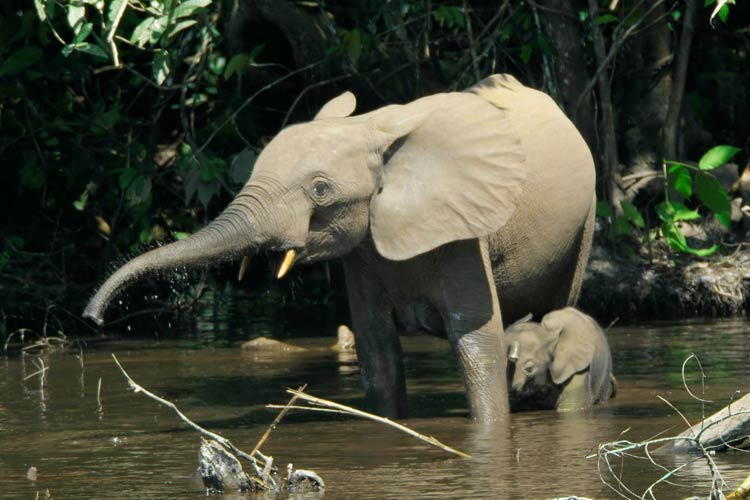
Distribution and habitat
The African forest elephant is native to the dense rainforests of Central and West Africa, with a range that stretches from Guinea in the west to Sudan in the east and from the Central African Republic in the north to the Democratic Republic of Congo in the south. These elephants are found in a variety of forest types, including lowland and montane rainforests, gallery forests, and swamp forests.
African forest elephants are adapted to living in dense and closed-canopy forest environments. They are able to navigate through the thick underbrush and narrow paths, thanks to their smaller size and more slender build. They also feed on a variety of plants, including fruits, leaves, and bark, as well as some mineral-rich soils. They are also known to consume certain species of woody plants, which is unusual among elephants.
However, the African forest elephant’s habitat is under threat from human activities such as logging, mining, and agriculture. These activities lead to fragmentation of the forest and destruction of the elephants’ food sources, making it difficult for them to survive. Additionally, the hunting of elephants for their ivory and meat also poses a significant threat to their survival. As a result, their population size has been reduced significantly and their distribution range is becoming more fragmented.
African forest elephants have a specific and restricted distribution range and habitat, and it’s mostly found in the dense rainforests of Central and West Africa, where they have adapted to live in closed canopy forest environments. However, the habitat of African forest elephants is under threat from human activities and hunting, which has reduced the population size and distribution range.

Characteristics
Physical Characteristics
- African forest elephants are smaller in size compared to their savannah-dwelling cousins, with a shoulder height of around 2.4–3.0 m (7 ft 10 in – 9 ft 10 in) and a weight of around 2,000 to 4,000 kg. They also have a more slender build, with longer legs and smaller ears.
- Their trunks are more flexible than those of savannah elephants, which allows them to grasp small branches and fruits more easily. They also have long, curved tusks that are used for foraging and defense.
- They have thick skin, which helps to protect them from insect bites and parasites, as well as from thorns and sharp branches in their forest habitat.
- They also have large ears which help them to dissipate heat, and keep them cool in the hot and humid forest environment.
Size
Adult African forest elephants typically have a shoulder height of around 2.4–3.0 m (7 ft 10 in – 9 ft 10 in) and a weight of around 2,000 to 4,000 kg (4,400 to 8,800 lbs). This is smaller than the African bush elephant, which typically has a shoulder height of around 3 to 4 meters (10 to 13 feet) and a weight of around 4,500 to 6,000 kg (9,900 to 13,200 lbs) and up to 10,400 kg (22,900 lb).
This smaller size is an adaptation to their forest habitat, where they need to navigate through dense vegetation and narrow paths. Their smaller size and more slender build also allow them to move more stealthily through the forest, which can help them to avoid predators and to sneak up on their prey.
The African forest elephant’s size can also be a disadvantage. They are less visible and harder to detect by poachers and researchers, making it more difficult to monitor their population and protect them.
African forest elephants are smaller in size than African savannah elephants, this is an adaptation to their forest habitat, enabling them to move through dense vegetation and narrow paths, but at the same time, their size can also make them more vulnerable to poaching and harder to detect by researchers.

Trunk
The African forest elephant’s trunk is one of its most notable adaptations to its forest habitat. The trunk is a highly versatile appendage that is used for a variety of tasks, including foraging, communication, and defense.
One of the main differences between the trunk of an African forest elephant and that of a savannah elephant is its flexibility. The African forest elephant’s trunk is more flexible and nimble than that of a savannah elephant. This allows it to grasp small branches and fruits more easily, and to navigate through dense vegetation and narrow paths in its forest habitat.
The trunk is also used for foraging, African forest elephants use their trunks to pluck fruits, leaves, and branches from trees and bushes, as well as to dig for roots, tubers, and minerals in the soil. Additionally, the trunk is used to communicate with others, using various forms of vocalizations, including trumpeting, rumbling, and low-frequency infrasonic calls.
The trunk is also used for defense, African forest elephants use their trunks to defend themselves against predators and to intimidate rivals. The trunk has a sensitive tip that can be used to detect potential threats, and the elephant can use it to pick up and throw objects, or to deliver a powerful blow.
The African forest elephant’s trunk is a highly versatile appendage that is adapted to its forest habitat. Its flexibility and nimbleness allow it to navigate through dense vegetation and narrow paths, while its sensitivity and strength allow it to forage, communicate, and defend itself effectively.

Tusks and molars
The African forest elephant’s tusks are another notable adaptation to its forest habitat. Tusks are elongated incisors that grow throughout the elephant’s life and are used for a variety of tasks, including foraging, defense, and communication.
African forest elephants have long, curved tusks that are used for foraging. They use their tusks to strip bark from trees and to dig for roots and tubers in the soil. The tusks also serve as a tool to open up logs and branches to access the nutritious inner bark and leaves, as well as to defend themselves from predators.
The African forest elephant’s molars are also adapted to their diet, which includes a variety of plants, including fruits, leaves, and bark, as well as some mineral-rich soils. They have large molars that are used to grind and crush tough vegetation, which allows them to extract nutrients from the plants they eat.
As the African forest elephant gets older, the molars wear down, and new molars grow in behind the old ones. This continuous replacement allows them to maintain their ability to feed throughout their lifetime, which is important since they live in an environment where food resources are scarce and seasonal.
The tusks and molars of African forest elephants are highly valued by poachers for their ivory, and this has led to a significant decline in their population. The hunting for their tusks and molars, is considered as one of the main threats to the survival of African forest elephants.
African forest elephant’s tusks and molars are adaptations to their forest habitat and diet. The tusks are used for foraging, defense, and communication, while the molars are used to grind and crush tough vegetation. However, this adaptation is also a reason for the elephants’ vulnerability and their population decline due to hunting for their tusks and molars.
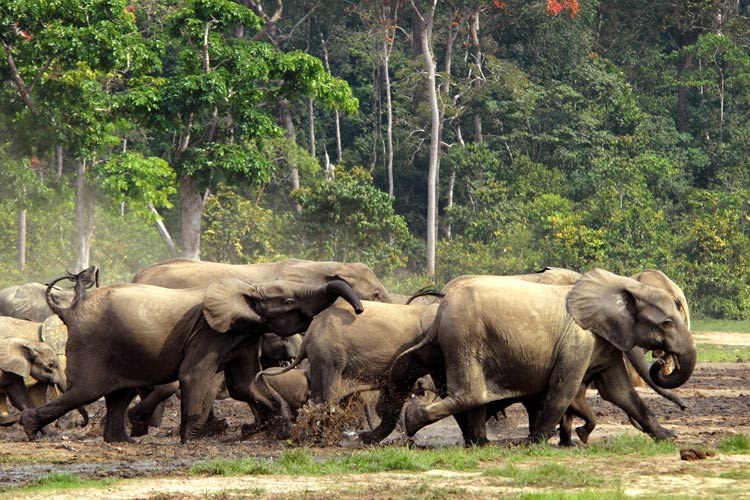
Diet
African forest elephants feed on a variety of plants, including fruits, leaves, and bark, as well as some mineral-rich soils. They are also known to consume certain species of woody plants, which is unusual among elephants. They consume large quantities of vegetation and play an important role in seed dispersal, helping to maintain the biodiversity of the forest ecosystem.
Behavior
African forest elephants have a unique behavior and ecology that is adapted to their forest habitat. One of the most notable differences between forest and savannah elephants is their social structure.
African forest elephants live in small family groups, typically consisting of a single adult female and her offspring. These groups are led by an older female, known as the matriarch, who is responsible for making decisions for the group and for protecting her offspring.
African forest elephants are active both during the day and at night, and spend most of their time foraging for food. They consume large quantities of vegetation and play an important role in seed dispersal, helping to maintain the biodiversity of the forest ecosystem.
They are also known to use vocalizations and various forms of physical contact to communicate with each other. For example, they use trumpeting, rumbling, and low-frequency infrasonic calls to communicate with members of their family group, and they use touch and scent to establish social bonds with other members of their group.
African forest elephants also have unique reproductive behavior. They have a gestation period of around 22 months, after which a single calf is born. Calves are dependent on their mothers for the first 2-3 years of their lives and stay with their mothers in the family group. Females reach sexual maturity at around 10-12 years old, while males reach maturity at around 15-20 years old.
The African forest elephant’s behavior and ecology are also strongly influenced by their habitat. They are adapted to living in dense and closed-canopy forest environments, and they are able to navigate through the thick underbrush and narrow paths thanks to their smaller size and more slender build.
African forest elephants have a unique behavior and ecology that is adapted to their forest habitat. They have a different social structure and reproductive behavior than savannah elephants, and they are also active both during the day and at night, and spend most of their time foraging for food.
- African forest elephants have a different social structure than savannah elephants. They live in small family groups, typically consisting of a single adult female and her offspring.
- They have a matriarchal society and live in tight-knit family groups that are led by an older female.
- They are active both during the day and at night, and spend most of their time foraging for food.
- They are also known to use vocalizations and various forms of physical contact to communicate with each other.
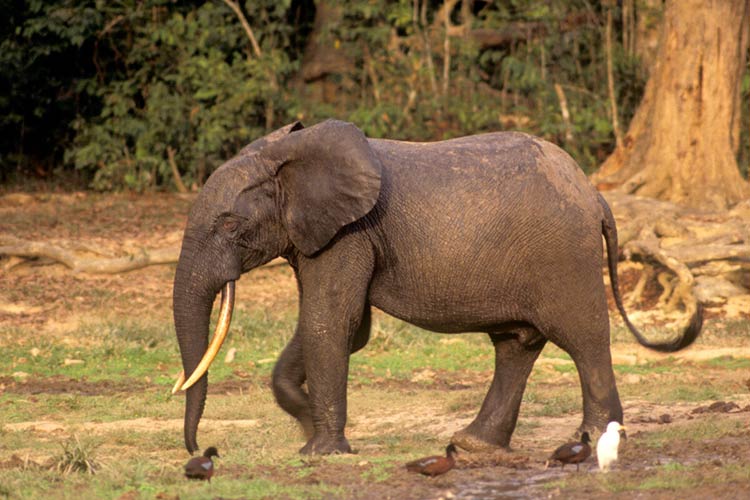
Reproduction
- African forest elephants have a gestation period of around 22 months, after which a single calf is born.
- Calves are dependent on their mothers for the first 2-3 years of their lives and stay with their mothers in the family group.
- Females reach sexual maturity at around 10-12 years old, while males reach maturity at around 15-20 years old.
- African forest elephants have a lifespan of around 60-70 years in the wild.
African forest elephants have unique characteristics that make them well-suited to their forest habitat, such as their smaller size, more slender build, and flexible trunks, which allow them to navigate through dense vegetation and narrow paths. They also have a specialized diet, and different social and reproductive behavior compared to the savannah elephants.

Threats
African forest elephants are facing a number of threats to their survival. The main threats include:
- Poaching
African forest elephants are often hunted for their tusks, which are highly valued for their ivory. The demand for ivory has led to a significant decline in the population of African forest elephants. - Habitat loss
The destruction of their habitat due to human activities such as logging, mining, and agriculture is also a major threat to their survival. These activities lead to the fragmentation of the forest and destruction of the elephants’ food sources, making it difficult for them to survive. - Climate change
Climate change is also affecting the African forest elephant’s habitat. The changes in temperature and rainfall patterns in the forest are expected to have a negative impact on the elephants’ food sources, and make it harder for them to survive. - Disease
African forest elephants are also at risk of contracting diseases that are spread by human activities. For example, they can contract diseases from domestic animals, and they can also contract diseases that are spread by people working in the forest. - Human-wildlife conflict
As human populations grow, they encroach on the forest habitat of the African forest elephants, leading to a conflict between humans and elephants. This can result in elephants being killed in retaliation for crop raiding and other human-elephant conflicts.
As a result of these threats, African forest elephants are considered to be endangered and are listed on the IUCN Red List of Threatened Species. Conservation efforts are needed to protect the African forest elephants and their habitat, in order to ensure their survival.
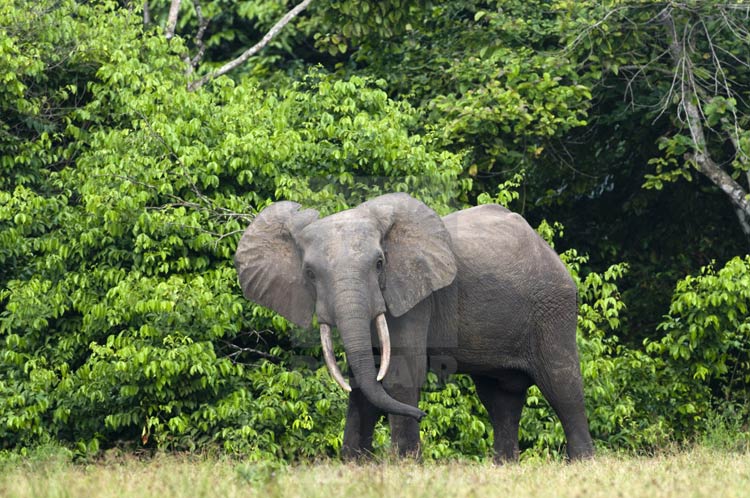
Conservation
Conservation efforts are needed to protect the African forest elephants and their habitat, in order to ensure their survival. Some of the main conservation strategies that are being used include:
- Anti-poaching measures
Efforts are being made to combat poaching through patrols, surveillance, and law enforcement. This includes monitoring and tracking of elephants, as well as efforts to disrupt and dismantle poaching networks. - Habitat protection
Efforts are being made to protect the African forest elephant’s habitat by creating protected areas, such as national parks and wildlife reserves. This includes efforts to limit human activities such as logging, mining, and agriculture, that can destroy the elephant’s habitat. - Research and monitoring
Research and monitoring are essential for understanding the African forest elephant’s biology, ecology, and behavior, as well as for identifying threats to its survival. This includes monitoring population trends and identifying key areas for conservation. - Community-based conservation
Community-based conservation efforts are being used to involve local communities in conservation efforts. This includes working with local communities to reduce human-elephant conflicts, and to develop sustainable livelihoods that do not rely on the destruction of the elephant’s habitat. - Education and awareness
Education and awareness-raising efforts are also important for conservation. This includes educating the public about the importance of conserving the African forest elephant and its habitat, and raising awareness about the threats to their survival. - International cooperation
International cooperation is also important for conservation. This includes working with other countries and organizations to combat poaching and habitat destruction, and to develop and implement conservation policies.
Conservation efforts are critical for protecting African forest elephants and their habitat, and for ensuring their survival. A combination of different strategies is needed, including anti-poaching measures, habitat protection, research and monitoring, community-based conservation, education and awareness, and international cooperation.

The differences between the African bush elephant (Loxodonta africana) and the African forest elephant (Loxodonta cyclotis)
The African bush elephant (Loxodonta africana) and the African forest elephant (Loxodonta cyclotis) are two subspecies of the African elephant, which are found in different habitats and have different adaptations to those habitats.
- Physical differences
The African bush elephant is larger in size compared to the African forest elephant, with a shoulder height of around 3 to 4 meters (10 to 13 feet) and a weight of around 4,500 to 6,000 kg (9,900 to 13,200 lbs). On the other hand, the African forest elephant has a shoulder height of around 2.4–3.0 m (7 ft 10 in – 9 ft 10 in) and a weight of around 2,000 to 4,000 kg (4,400 to 8,800 lbs). Additionally, African bush elephants have larger ears, which they use to dissipate heat, while African forest elephants have a more slender build and longer legs, which help them navigate through dense vegetation and narrow paths in the forest. - Habitat
African bush elephants are found in savannah and grassland habitats, while African forest elephants are found in dense rainforests of Central and West Africa. The African bush elephant is adapted to living in open habitats with little cover, while the African forest elephant is adapted to living in closed-canopy forest environments. - Diet
African bush elephants are herbivores, and their diet mainly consists of grasses, fruits, and leaves, while African forest elephants also feed on a variety of plants, including fruits, leaves, and bark, as well as some mineral-rich soils. They are also known to consume certain species of woody plants, which is unusual among elephants. - Behavior and social structure
African bush elephants have a matriarchal society and live in large family groups, which can have dozens of individuals. African forest elephants have a different social structure than savannah elephants. They live in small family groups, typically consisting of a single adult female and her offspring. - Reproduction
African bush elephants have a gestation period of around 22 months, after which a single calf is born, while African forest elephants have a slightly longer gestation period of around 22-23 months, after which a single calf is born. - Conservation Status
African bush elephant is considered “Vulnerable” by the IUCN Red List, while African forest elephants are considered “Critically Endangered”.
African bush elephant and African forest elephant are two subspecies of the African elephant, which are found in different habitats, have different adaptations to those habitats, different physical characteristics, diet, social structure and reproduction, and have different conservation status.
African bush elephants are adapted to living in open habitats with little cover, while African forest elephants are adapted to living in closed-canopy forest environments. African bush elephants have larger ears and are larger in size, while African forest elephants have a more slender build, longer legs, and a more flexible trunk.
African bush elephants have larger family groups and matriarchal society, while African forest elephants have smaller family groups led by a single adult female. The African bush elephant is considered as “Vulnerable” by the IUCN Red List, while African forest elephants are considered as “Critically Endangered”.
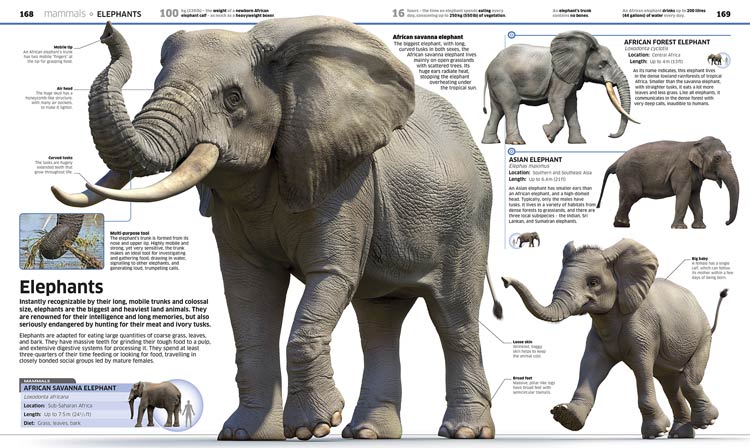
Detailed data / dimensions (size)
African forest elephant (Loxodonta cyclotis)
- Body length: Head-body (including trunk) 600 – 750 cm (236 – 295 in)
- Tail: 100 – 150 cm (39 – 59 in)
- Height at the withers:
- males: 2.4–3.0 m (7 ft 10 in – 9 ft 10 in)
- females: 1.8–2.4 m (5 ft 11 in – 7 ft 10 in)
- Weight:
- males: 2,700-6,000 kg (5,950 – 13,230 lb)
- females: 2,000–4,000 kg (4,400–8,800 lb)
- Tusks:
- length: 1.5 m (4 ft 11 in)
- weight: 23 and 45 kg (50 and 100 lb)
- Foot print size: 12.5 – 35.3 cm (4.9 – 13.9 in)

Interesting facts about African forest elephant
- Smallest subspecies
African forest elephants are the smallest subspecies of African elephants. - Unique trunk
The African forest elephant has a more flexible and elongated trunk, which allows them to manipulate food in a complex environment and reach high branches to feed on leaves and fruits. - Habitat specialists
African forest elephants are the only elephants that have evolved to live in dense rainforests, where they have adapted to navigating narrow paths and crossing streams. - Specialist feeders
African forest elephants are known for their specialized diet, which includes a variety of plants, including fruits, leaves, bark, and mineral-rich soils. They are also known to consume certain species of woody plants, which is unusual among elephants. - Low-density populations
Unlike their savannah counterparts, African forest elephants have low-density populations and are widely dispersed, which makes them more vulnerable to habitat loss and poaching events. - Role in seed dispersal
African forest elephants play a crucial role in seed dispersal in their forest habitat, helping to maintain the health and diversity of the forest. - Endangered
African forest elephants are considered “Critically Endangered” by the IUCN Red List due to habitat loss and poaching events caused by illegal ivory trade and human activity. - Unique genetic signature
African forest elephants have a unique genetic signature, different from their savannah relatives, and are considered a distinct species by some scientists. - Social structure
African forest elephants have a different social structure than savannah elephants, living in small family groups, typically consisting of a single adult female and her offspring.
African forest elephants are fascinating animals, with unique adaptations to their forest habitat, specialized feeding behaviors, and a crucial role in seed dispersal. Despite their importance to the health and diversity of their habitat, they are considered “Critically Endangered” and face significant threats from human activities.

Q&A (questions and answers) about African forest elephant
Q: What is the scientific name of the African forest elephant?
A: The scientific name of the African forest elephant is Loxodonta cyclotis.
Q: Where are African forest elephants found?
A: African forest elephants are found in the dense rainforests of West and Central Africa, including countries such as Cameroon, the Central African Republic, the Democratic Republic of Congo, Equatorial Guinea, Gabon, and the Republic of Congo.
Q: What is the average height and weight of an African forest elephant?
A: African forest elephants have a shoulder height of around 2.4–3.0 m (7 ft 10 in – 9 ft 10 in) and a weight of around 2,000 to 4,000 kg (4,400 to 8,800 lbs).
Q: What is the difference between the trunk of an African forest elephant and that of an African bush elephant?
A: The African forest elephant has a more flexible and elongated trunk, which allows them to manipulate food in a complex environment and reach high branches to feed on leaves and fruits. African bush elephants have thicker and more robust trunk.
Q: What is the social structure of African forest elephants?
A: African forest elephants have a different social structure than savannah elephants, living in small family groups, typically consisting of a single adult female and her offspring.
Q: What is the diet of African forest elephants?
A: African forest elephants have a specialized diet, which includes a variety of plants, including fruits, leaves, bark, and mineral-rich soils. They are also known to consume certain species of woody plants.
Q: What is the conservation status of African forest elephants?
A: African forest elephants are considered “Critically Endangered” by the IUCN Red List due to habitat loss and poaching events caused by illegal ivory trade and human activity.
Q: What role do African forest elephants play in their forest habitat?
A: African forest elephants play a crucial role in seed dispersal in their forest habitat, helping to maintain the health and diversity of the forest.
African forest elephants are fascinating animals with unique adaptations to their forest habitat and important roles in maintaining the health and diversity of their ecosystem. However, they face significant threats and are considered “Critically Endangered”.


